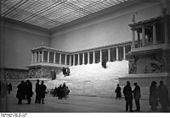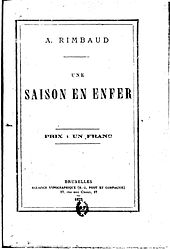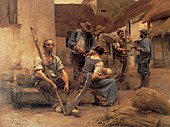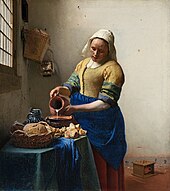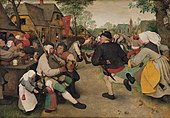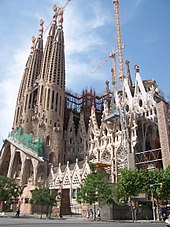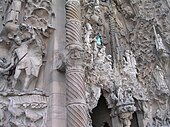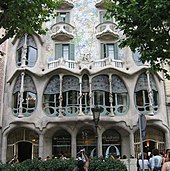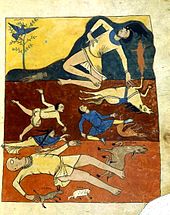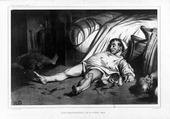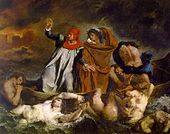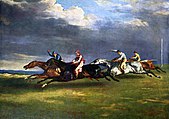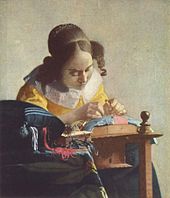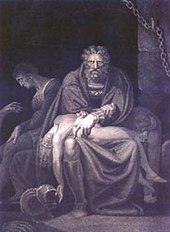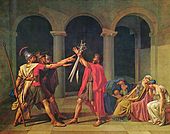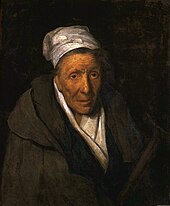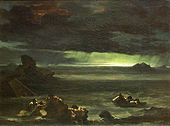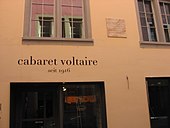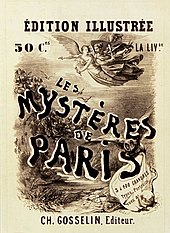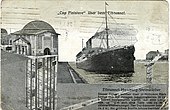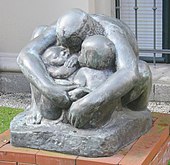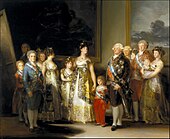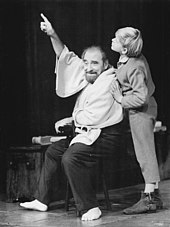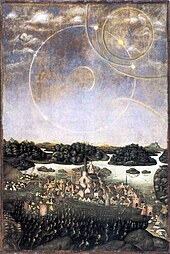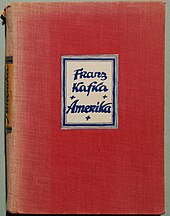Works of art in the "aesthetics of resistance"

The multitude of works of art in the “Aesthetics of Resistance” , which Peter Weiss incorporated into his novel The Aesthetics of Resistance , form a kind of musée imaginaire (imaginary museum) with more than a hundred named artists and as many works of art , mainly the visual arts and of literature , but also of music and the performing arts .
Peter Weiss wrote the three-volume, 1000-page novel between 1971 and 1981. The plot is set between 1936 and 1945, the locations are Nazi Berlin, Spain during the civil war , Paris before the Second World War and Stockholm as one of the places of refuge for German exiles . The figures are based on real personalities, the main actors organize themselves in the resistance group of the so-called Red Orchestra . Representations of artists, works of art, their contexts and backgrounds are included in the storyline and form a network of mutual interdependencies. The reception takes place in multilayered considerations by the protagonists of the novel, through the reference to historical and political events, to mythological set pieces, to artist biographies, to dream images or in critical questioning:
“If we want to take care of art and literature, we have to treat it against the grain, that is, we have to eliminate all privileges associated with it and place our own claims on them. In order to come to ourselves (...), we not only have to recreate the culture, but also the entire research by placing it in relation to what concerns us. "
List of works of art
The following list contains around one hundred works of art of the visual arts, literature and music that are extensively discussed, named, enumerated or included in the Aesthetics of Resistance . In addition, motifs from mythology as well as events and places that are directly related to Peter Weiss' art receptions are included in the list. The works of art and backgrounds are largely arranged in the order in which they appear in the book. Exceptions are motifs which, after a brief mention, are given a more detailed description on later pages. The approximately one hundred artists depicted in the novel can be found in the list of artists in the “Aesthetics of Resistance” .
By clicking on the arrow in the table headings, the list can be sorted differently; a detailed description of the sorting options can be found after the table .
| Illustration / chronology | Artist / origin | Work / classification | In the novel |
|---|---|---|---|
| Antiquity |
Pergamon Altar first half of the 2nd century BC Chr. Berlin, Pergamon Museum Building AedW I, pp. 7-15, 36-53, 316 f., 328; |
discussed in detail: The description of the Pergamon Altar and the gigantomachy represented by it form the introduction to the novel. The protagonists question the viewer's point of view: they see the victorious gods as symbols of the rulers who had the monumental work of art created by the exploited; war is stylized as a myth. They identify with the beaten children of the Ge and discuss the role of Heracles . |
|
| Greek mythology |
Gigantomachy Mythology AedW I, p. 7 ff. |
discussed or mentioned: The representation and reception of the gigantomachy occupies a central space with the description of the Pergamon Altar in the introduction and is taken up several times in the course of the novel. It stands as a symbol for the struggle of the resistance against fascism. |
|
| Greek mythology |
Ge Mythology AedW I, p. 10 ff .; AedW III, p. 20 |
discussed or mentioned: The motif of the Ge becomes the figure of the identification of the protagonists: |
|
| Greek mythology |
Heracles Mythology AedW I, pp. 18-25, 62, 314 ff. |
discussed in detail: The motif of Heracles is a central, recurring parable and stands as a critically questioned symbol for the oppressed or the working class. The absence of his figure in the Pergamon Altar leads to the recurring element of the search for Heracles, which ends at the end of the novel. |
|
| Antiquity |
Market gate of Miletus around 120 BC Chr. Berlin, Pergamon Museum Building AedW I, pp. 15, 324 f., 327 |
discussed or mentioned: The protagonists also visit this building during their visit to the Pergamon Museum. The history of the city of Miletus is taken up again elsewhere in the novel in the portrayal of antiquity as a wealth-accumulating slave-holding society. |
|
| antiquity |
Ishtar Gate 6th century BC Chr. Berlin, Pergamon Museum Structure AedW I, p. 15 |
discussed or mentioned: When visiting the Pergamon Museum, the protagonists walk along this building, "getting a few centuries deeper." |
|
| Paul Otto |
Wilhelm von Humboldt monument 1883, marble statue Berlin, Unter den Linden Fine arts AedW I, p. 15 |
discussed or mentioned: As they walk through Berlin, the protagonists point to "the Humboldt brothers who are enthroned in armchairs with griffin feet and ponder over open books" . |
|
| Reinhold Begas |
Alexander von Humboldt monument 1883, marble statue Berlin, Unter den Linden Fine arts AedW I, p. 15 |
discussed or mentioned: As they walk through Berlin, the protagonists point to "the Humboldt brothers who are enthroned in armchairs with griffin feet and ponder over open books" . |
|
| Arthur Rimbaud |
Une Saison en enfer (A time in hell) 1873 collection of poems Literature AedW I, p. 58; AedW II, p. 68 |
discussed or mentioned: In the question of the novel about the possibilities of the poorly educated working class to appropriate culture, the protagonists use Rimbaud as an example to discuss the intelligibility of language in relation to its trivialization: “Both are correct (...), the grip that holds the ground for us tear away from under your feet, as well as the endeavor to create a solid basis for the investigation of simple facts. ” The work is mentioned again in the second volume when the first-person narrator tries to get to know the city of Paris on the trail of various artists. |
|
| Ilya Repin |
Treidler on the Volga 1870–1873, oil on canvas, 131.5 × 281 cm St. Petersburg, Russian Museum Visual arts AedW I, p. 60 |
discussed or mentioned: as an example of Russian realism: |
|
| Konstantin Sawizki |
Repair work on the railroad 1874, oil on canvas, 100 × 175 cm Moscow, Tretyakov Gallery Visual arts AedW I, p. 60 |
discussed or mentioned: as an example of Russian realism: |
|
| Vasily Perov |
Troika 1866, oil on canvas, 123.5 × 167.5 cm Moscow, Tretyakov Gallery Visual arts AedW I, p. 60 |
discussed or mentioned: as an example of Russian realism: |
|
| Nikolai Yaroshenko |
The Stoker 1878, oil on canvas, 124 × 89 cm Moscow, Tretyakov Gallery Visual arts AedW I, p. 60 |
discussed or mentioned: as an example of Russian realism: |
|
| Gustave Courbet |
Die Steinklopfer 1849/50, oil on canvas, 165 × 257 cm formerly Dresden, Gemäldegalerie; burned Visual arts AedW I, pp. 60f. |
discussed or mentioned: as an example of French realism: |
|
| Gustave Doré |
London: a pilgrimage 1872, illustrations in William Jerrold's tale about London, 180 wood engravings in total Visual arts AedW I, p. 61 |
discussed or mentioned: as an example for the representation of workers and their living environment: "... but they were not exposed to the abandonment of Wet, but toiled in a living circle." |
|
| Jean-François Millet |
Gleaners (Des glaneuses) 1857, oil on canvas, 84 × 111 cm Paris, Musée d'Orsay Visual arts AedW I, p. 61f. |
discussed or mentioned: Description and interpretation of the painting as well as the motif background in connection with explanations of realism, in which the workers are depicted in works of art and their images are lifted into the salons of society: “by removing the sweaty figures with their earthy features, their clayey weight from where they had previously remained anonymously, and placed between the neat portraits, the nymphs and shepherdesses, he did something that was tantamount to the revolutionary cause. " |
|
| Jean-François Millet |
Man with the Hoe 1863, oil on canvas, 80 × 99 cm USA, private collection Visual arts AedW I, p. 62 |
discussed or mentioned: Interpretation of the painting in connection with explanations of realism, in which the workers are depicted in works of art and their images are lifted into the salons of society. |
|
| Jean-François Millet |
Two men with spades 1855/1856, oil on canvas, 81 × 100 cm Minnesota, Duluth Tweed Museum of Art Visual arts AedW I, p. 62 |
discussed or mentioned: Interpretation of the painting in connection with explanations of realism, in which the workers are depicted in works of art and their images are lifted into the salons of society. |
|
| Jean-François Millet |
Sower 1850/1851, oil on canvas, 101 × 82.5 cm Boston, Museum of Fine Arts Visual arts AedW I, p. 62 |
discussed or mentioned: Interpretation of the painting in connection with explanations of realism, in which the workers are depicted in works of art and their images are lifted into the salons of society. |
|
| Jean-François Millet |
The ringing of the angelus 1857/1859, oil on canvas, 55.5 × 66 cm Paris, Louvre Visual arts AedW I, p. 62 |
discussed or mentioned: Interpretation of the painting in connection with statements on realism, in which the workers are depicted in works of art and their images are lifted into the salons of society: "But now they could no longer be refused, frightening, even when they were standing by the evening bell." |
|
| Léon Augustin Lhermitte |
Paying the Harvesters 1892, oil on canvas, 214 × 272 cm Paris, Musée d'Orsay Visual arts AedW I, p. 63 |
discussed or mentioned: Enumerated as an example of the representation of the self-confidence of the working class in France after the revolution: "The harvest workers in the picture of Lhermitte received their daily allowance from the manager, standing upright, without humility." |
|
| Constantin Meunier |
Monument of Labor 1880, bronze and stone relief Brussels, Quartier de Laeken Fine arts AedW I, p. 63 |
discussed or mentioned: Enumerated as an example of the representation of the self-confidence of the working class in France after the revolution: "Meunier's miners, dockworkers loomed in motionlessness, in deep seriousness, strength penetrated them, but they did not raise their hands." |
|
| Vladimir Tatlin |
Monument for the Third International (Tatlin Tower), 1917, model draft lost Building AedW I, p. 66f. |
content included In the discussion between the protagonists about the importance of the Russian avant-garde for the revolution, this draft is an example, not explicitly mentioned, of the limits it reached: |
|
| Albrecht Dürer |
The prodigal son 1496/97, copper engraving, 24.8 × 18.6 cm Visual arts AedW I, p. 76 |
discussed or mentioned: In comparison with Dürer's graphic of Melencolia , which he created in 1514, it “clearly showed the separation between hierarchical art and that which was entirely on its own and had to make its own choice.” The prodigal son becomes the Christian Associated with iconography , Melencolia, however, Neo-Platonic ideas . |
|
| Greek mythology |
Mnemosyne
Mythology AedW I, p. 77; AedW III, p. 134 |
discussed or mentioned: It is juxtaposed with the fascist iconoclasts and book burnings : “It protects that which, in the overall achievements, contains our own knowledge. She whispers to us what our impulses demand. Anyone who presumes to breed and chastise this stored good will attack us and condemn our |
|
| Dante Alighieri |
Divina Commedia (The Divine Comedy) 1307–1321, verse narration Literature AedW I, p. 79 ff. |
discussed in detail: The Divine Commode occupies a central position, as it is not only discussed in detail, but also reminds Peter Weiss' novel in parts of a journey through worlds. The protagonists reflect on the knowledge and worlds that open up to them with Dante and thus on the importance of education for the working class: “It was not enough to draw attention to the fact that the libraries were open, first the generation-old obsession that the book was not there for you to be overcome. " |
|
| James Joyce |
Ulysses 1914–1921, novel Literature AedW I, p. 79 |
discussed or mentioned: Ulysses is classified by the protagonists as just as unsettling, rebellious, formally and thematically alien as Dante's Divina Commedia and thus placed in relation to her. |
|
| Piero della Francesca |
Finding and testing the true cross from the cycle The Legend of the True Cross around 1466, fresco, 356 × 747 cm Arezzo, San Francesco Fine arts AedW I, p. 84 |
discussed or mentioned: The protagonists consider the class separation that is laid out in the pictures and question what teaching material the exclusive, demanding art of the rulers and the privileged can offer for them as seekers. On this it is the "geometrically fancy walls" of the cityscape of Arezzo, "the green-blue of the sky that was absorbed by the strangely intact ground, all of this was from a vision that avoided any emotion." |
|
| Piero della Francesca |
The victory of Constantine over Maxentius from the cycle The legend of the true cross around 1466, fresco, 329 × 747 cm Arezzo, San Francesco Fine arts AedW I, p. 84 |
discussed or mentioned: The protagonists consider the class separation that is laid out in the pictures and question what teaching material the exclusive, demanding art of the rulers and the privileged can offer for them as seekers. It is in particular the two battle paintings of the cycle and the constructed representation of the soldiers that get their attention. |
|
| Piero della Francesca |
The battle between Heraclius and Chosroes from the cycle The legend of the true cross around 1466, fresco, 329 × 747 cm Arezzo, San Francesco Fine arts AedW I, p. 85 Group of |
discussed or mentioned: The protagonists consider the class separation that is laid out in the pictures and question what teaching material the exclusive, demanding art of the rulers and the privileged can offer for them as seekers. It is in particular the two battle paintings of the cycle and the constructed representation of the soldiers that get their attention. |
|
| Hieronymus Bosch |
Hay cart triptych around 1490, oil on wood, middle section 135 × 100 cm Madrid, Prado Visual arts AedW I, p. 86 |
content included: Example of a list in which Peter Weiss explains how the faces of the farmhands and maidservants stood out in the works that were dedicated to the preferred: “ At Mantegna and Masaccio , Grien , Grünewald and Dürer , at Bosch , Brueghel and Goya , the workers stepped already in the foreground. ” |
|
| Nicolas Poussin |
Et in arcadia ego 1637–1638, oil on canvas, 87 × 120 cm Paris, Louvre Fine arts |
discussed or mentioned: Example of a list in which Peter Weiss explains how the faces of the servants and maidservants emerged in the works that were dedicated to the preferred: "The shepherds and fishermen who had accepted their decorative functions suddenly lost, in pictures by Poussin , their simplicity and gentleness (...). ” |
|
| Georges de La Tour |
Joseph as a carpenter around 1640, oil on canvas, 137 × 101 cm Paris, Louvre Fine arts |
content included: Example of a list in which Peter Weiss explains how the faces of the servants and maidservants emerged in the works that were dedicated to the preferred ones: “A blacksmith, a carpenter at La Tour were so outstanding with their work that they alone were able to visualize (...) received. " |
|
| Jean Siméon Chardin |
The Laundress 1733, oil on canvas, 37 × 42.5 cm St. Petersburg, Hermitage Fine arts |
content included: Example of a list in which Peter Weiss explains how the faces of the servants and maidservants emerged in the works that were dedicated to the preferred: “Vermeer, Chardin did not keep maturity and beauty from the superiors, but left them to the seamstress, the laundress to come to the maid. " |
|
| Jan Vermeer |
Maid with milk jug 1658–1660, oil on canvas, 45 × 41 cm Amsterdam, Rijksmuseum Fine arts |
content included: Example of a list in which Peter Weiss explains how the faces of the servants and maidservants emerged in the works that were dedicated to the preferred: “Vermeer, Chardin did not keep maturity and beauty from the superiors, but left them to the seamstress, the laundress to come to the maid. " |
|
| Giotto di Bondone |
The Annunciation to Anna from the cycle Scenes from the Life of Jesus and the Life of the Blessed Virgin Mary and Her Parents 1304–1306, fresco, 38 scenes Padua, arena chapel Fine arts |
discussed or mentioned: Symbol in the dream of the first-person narrator, in which he uses the images of his barren apartment with the cycle by Bondone and a surreal scene is created. In the memories of the parents, the father appears as Joachim and the mother as Anna: |
|
| Giotto di Bondone |
The death of the noble von Celano from the cycle The legend of St. Francis 1297-1300, fresco, 28 scenes Assisi, Basilica of San Francesco Fine arts |
discussed or mentioned: Symbol in the dream of the first-person narrator, in which various frescoes flow into the images of the first-person narrator, here the barely empty apartment changes to a projection of the table. |
|
| Giotto di Bondone |
Saint Francis in a fiery chariot from the cycle The legend of Saint Francis 1297–1300, fresco, 28 scenes Assisi, Basilica of San Francesco Fine arts |
discussed or mentioned: Symbol in the dream of the first-person narrator with a surreal resurrection image of the father from the kitchen floor and a flight vision: |
|
| Johann Wolfgang von Goethe |
Wilhelm Meister's Wanderjahre 1821/29, novel Literature |
discussed or mentioned: Example of the span of the social novel in which the educated bourgeoisie is represented: “Because from Wilhelm Meister to the Buddenbrooks, the world that set the tone in literature was seen through the eyes of those who owned it such attention to detail and personality are encompassed in the richness of all stages of development. " |
|
| Thomas Mann |
The Buddenbrooks 1901, novel Literature |
discussed or mentioned: Example of the span of the social novel in which the educated bourgeoisie is represented: “Because from Wilhelm Meister to the Buddenbrooks, the world that set the tone in literature was seen through the eyes of those who owned it such attention to detail and personality are encompassed in the richness of all stages of development. " |
|
| Pierre-Nolasque Bergeret |
Colonne Vendôme 1806–1810, Victory Column Paris, Place Vendôme Fine arts |
discussed or mentioned: Description of the fall: “In the rubble, in a cloud of dust, lay the Emperor, with a toga and a laurel wreath. His betrayal of the revolution had been atoned for. " |
|
|
|
John Heartfield |
The meaning of the Hitler salute. Motto: Millions stand behind me 1932, photo montage, 36.2 × 26.67 cm Fine arts |
content included: Example of the cultural contributions in the Arbeiter Illustrierte (AIZ). |
| background |
Urgent appeal 1932, appeal With the urgent appeal in June 1932, well-known personalities called for tactical cooperation between the SPD and KPD against the growing NSDAP. |
discussed or mentioned: List of artists who supported the urgent appeal, as well as inclusion of later calls that were initiated by Willi Münzenberg , editor of the AIZ. |
|
| background |
Lutetia district 1935–1937, merger The Lutetia Circle was a committee made up of artists and politicians from various currents, primarily from the SPD and KPD environment, who met for several meetings between 1935 and 1937 in the Hôtel Lutetia in Paris to reach an anti-fascist consensus against the Nazi regime Find. |
discussed or mentioned: List of artists who took part in the Lutetia Circle and allusion to Heinrich Heine's essay Lutetia . |
|
| Klaus Neukrantz |
Barricades on Wedding 1931, novel of a street from the Berlin May days, Literature |
discussed or mentioned: Description of the May riots based on and discussion of the novel by Neukrantz. |
|
| Heinrich Heine |
Lutetia 1854, essay on politics, art and popular life Literature |
discussed or mentioned: Excerpt from Heine's work as an ironic allusion to the participants of the Lutetia circle : |
|
| George grosz |
Café 1919, oil on canvas Fine arts |
content included: Example of art that could express the feelings of the first-person narrator, the hatred of greed and self-interest, the murderous disgust for exploitation, subjugation and torture: |
|
|
|
Otto Dix |
Triumph of Death 1934, oil on canvas Stuttgart, Art Museum Fine arts |
content included: Example of art that could express the feelings of the first-person narrator. |
|
|
John Heartfield |
War and Corpses - The Last Hope of the Rich 1932, photomontage Fine arts |
content included: Example of art that could express the feelings of the first-person narrator. |
| Pieter Brueghel the Elder |
The fight between carnival and Lent 1559, oil on wood, 118 × 164.5 cm Vienna, Kunsthistorisches Museum Fine arts |
discussed or mentioned: Description of the painting in many details, the content as a poor dream of gluttony with the conclusion: “There was not a trace of pleasure and sociability in the paintings that depicted popular life.” |
|
| Pieter Brueghel the Elder |
The gloomy day 1565, oil on panel, 118 × 163 cm Vienna, Kunsthistorisches Museum Fine arts |
discussed or mentioned: Listed as an example of Brueghel's representations of farm workers, artisans, farmers and others who are all joyless and marked by "almost stupid dullness" in all their activities "whether they cut crops from the willow trees under a stormy sky (...)" |
|
| Pieter Brueghel the Elder |
Tower of Babel 1563, oil on wood, 114 × 155 cm Vienna, Kunsthistorisches Museum Fine arts |
discussed or mentioned: Listed as an example of Brueghel's representations of farm workers, craftsmen, farmers, "(...) whether they built the enormous housing of the Babylonian Tower around the rocky peaks," |
|
| Pieter Brueghel the Elder |
Carrying the Cross 1564, oil on wood, 124 × 170 cm Vienna, Kunsthistorisches Museum Fine arts |
discussed or mentioned: Listed as an example of Brueghel's representations of farm workers, craftsmen, farmers, "(...) whether they led Jesus to the crucifixion," |
|
| Pieter Brueghel the Elder |
Peasant Dance 1568, oil on panel, 114 × 164 cm Vienna, Kunsthistorisches Museum Fine arts |
discussed or mentioned: Listed as an example of Brueghel's portrayals of farm workers, craftsmen, farmers, "(...) or whether they turned in a round dance at the fair." |
|
| Pieter Brueghel the Elder |
Landscape with the fall of Icarus 1558, oil on panel, 73.5 × 112 cm Brussels, Musées royaux des Beaux-Arts de Belgique Fine arts |
discussed or mentioned: Description of the painting with reference to the indifferent attitude of the people in the picture and the depiction of the aphorism: “No plow stops for the sake of a dying man. (...) The interwoven motif of the proverb focused on the imperturbability of earthly work, but also held on to its heaviness and joylessness. " |
|
| Pieter Brueghel the Elder |
The Bethlehemite Child Murder 1565–1567, oil on panel, 111 × 160 cm Vienna, Kunsthistorisches Museum Fine arts |
discussed or mentioned: Description of the painting with reference to the nameless despair and the inescapability of the gruesome: “What happened between the inhabitants and the mercenaries, who were their kind, who only, as always, carried out the orders of their superiors, was unbearable, and it in his constant gestures of horror, of cold slaughter, stamped forever in the iconic white surface. ” |
|
| Franz Kafka |
The castle unfinished novel, 1922 Literature |
discussed in detail: Description and explanations of the insights the narrator draws from the novel for himself. In particular, he sees parallels to the reality of the oppressed and exploited in the non-questioning of rule and the resulting hopelessness, and that precisely because of this, the situation arises that the position that everyone occupies in society is not questioned, but only about it Recognition is fought, even when it comes to doing unrelated work: |
|
| Romain Rolland |
Jean Christophe 1904–1912, novel Literature |
discussed or mentioned: Example in the development of workers' education : "The language that was connected with our everyday dealings had expanded, suddenly we understood poems that apparently had nothing to do with our stamp cards, our inventory lists, our wage negotiations and union meetings." |
|
| André Gide |
The counterfeiters 1925, novel Literature |
discussed or mentioned: Example in the development of workers' education. |
|
| Knut Hamsun |
Hunger 1890, novel Literature |
discussed or mentioned: Example in the development of workers' education. |
|
| Elias Canetti |
The glare 1931/32, novel Literature |
discussed or mentioned: Example in the development of workers' education : “We started stammering, and while reading (...) we kept returning to the zero point, where our own lives had started. (...) If the building blocks were books for us, Prefessor Kien, Canetti's book man, perished between literature. " |
|
| Louis-Ferdinand Celine |
Journey to the End of the Night 1932, novel Literature |
discussed or mentioned: Example in the development of workers' education : “When artists who came from the bourgeoisie expressed their weariness, their lack of belonging, they might still be stuck in their origins by digging into individual pain, but with writing they were still there, themselves to approach those who saw an unnecessary, luxurious expense in their work. " |
|
| Antoni Gaudí |
Sagrada Família unfinished basilica, begun in Barcelona in 1882 Building |
discussed in detail: Description of the building and discussion of the political contradictions that the first-person narrator ponders over during the tour. The cathedral stands as a symbol of the “banality of an empty, lying religion” and is comparable to the tendencies of the revolutionary movement, which is held down by its leadership in petty-bourgeois idealism. |
|
| Antoni Gaudí |
Hope portal east facade of the Sagrada Família, 1891–1900 Barcelona Fine Arts |
discussed or mentioned: The motif of the Bethlehemite child murder, discussed several times in the novel, can also be found in a group of sculptures at the Sagrada Família : “The armored warrior, with the cast iron sword in one hand, throwing up the kidnapped child with the other, the woman pleading for a halt next to him the children's corpse hanging down the chattering geese. " |
|
| Antoni Gaudí |
Casa Batlló 1877, Barcelonabuilding, Passeig de Gracia Building |
discussed or mentioned: The building is also visited by the protagonists during their stay in Barcelona. |
|
| Antoni Gaudí |
Casa Milà 1906–1910, Barcelonabuilding, Passeig de Gràcia Building |
discussed or mentioned: The building is also visited by the protagonists during their stay in Barcelona. |
|
| Claude Joseph Rouget de Lisle |
Marseillaise 1792, song, French national anthem Music |
discussed or mentioned: Controversy about the necessity of slogans and their banalization of the context, compared to Gaudí's Sagrada Família : “Every movement needed its simplifications and summaries, including the text of the Marseillaise, the International had words for those concerned that they had long known by heart but wanted to hear again and again. " |
|
| Eugène Pottier (text), Pierre Degeyter (melody) |
Die Internationale 1871/1888, song, hymn of the socialist labor movement Music |
discussed or mentioned: Controversy about the necessity of slogans and their banalization of the context, compared to Gaudí's Sagrada Família : “Every movement needed its simplifications and summaries, including the text of the Marseillaise, the International had words for those concerned that they had long known by heart but wanted to hear again and again. " |
|
| Miguel de Cervantes |
Don Quixote 1605/1615, novel Literature |
content included: The character Don Quixote is performed repeatedly, especially during the stay of the first-person narrator in Spain: as an epic of Spain, "in which frenetically the overcoming of evil, justice, human dignity was sought and in which failure due to falsehood was always malice and deceit prevailed “ , as a motif of a mural in Albacete, in the thought of heroic productions. |
|
| background |
International Brigades The International Brigades were voluntary associations that fought on the side of the Spanish Republic in the Spanish Civil War from 1936 to 1938 against the fascist associations of the Spanish National Coalition led by Franco . AedW I, p. 224
|
discussed or mentioned: List of artists who joined or supported the International Brigades. |
|
| Richard Wagner |
Tannhäuser Overture 1842–1845, opera Music |
discussed or mentioned: Symbol in a gathering of internationalists in a former palace in Albacete that served as an infirmary. The role music from Wagner and others , which was just there, was played on an art piano : “The red flag, which hung from the glass roof high up to the gallery on the first floor, (...) was part of the attempt to bring about a change in the essence of the requisitioned building , but the perforated rolls that had been pushed into the piano case at the beginning of the meeting had (...) rather hammered down the ghost. " |
|
| Pietro Mascagni |
Cavalleria rusticana 1890, opera Music |
discussed or mentioned: Symbol in a gathering of internationalists in a former palace in Albacete that served as an infirmary. On a synthetic playing piano the existing flat there was role music by Mascagni and other hook. |
|
| Jean Sibelius |
Valse triste 1904, waltz Music |
discussed or mentioned: Symbol in a gathering of internationalists in a former palace in Albacete that served as an infirmary. On a synthetic playing piano the existing flat there was roll music of Sibelius and other hook. |
|
| Giuseppe Verdi |
March from Aida 1871, opera Music |
discussed or mentioned: Symbol in a gathering of internationalists in a former palace in Albacete that served as an infirmary. At the end of the gathering, Verdi's role music, which was just there, was played on an art piano . |
|
| Francisco de Goya |
Los Caprichos 1796–1797, 80 aquatint etchings Fine arts |
discussed or mentioned: The first-person narrator describes his ideas of the country and republic of Spain as being shaped, among other things, by Goya's satirical papers by the Caprichos . |
|
| Francisco de Goya |
Desastres de la Guerra 1810–1814, 82 etchings Fine arts |
discussed or mentioned: The first-person narrator's ideas of the country and republic of Spain are shaped , among other things, by Goya's graphic series Der Desastres . In the novel, they are considered a metaphor in the sense of the title of the first sheet of the series Sad Foreboding of What Must Happen . |
|
| middle Ages |
Castillo de Dénia 11th and 12th centuries Dénia Building |
discussed or mentioned: Description and examination of the Spanish history of colonialism from antiquity through the Reconquista to the Spanish Civil War |
|
|
|
Pablo Picasso |
Guernica 1937, oil on canvas, 349 × 776 cm Madrid, Museo Reina Sofía Fine arts |
discussed in detail: Discussion and interpretation of the painting both on the basis of the creation process documented photographically by Dora Maar , the art-historical debate of the contemporary novel as well as a detailed comparison with myths, motifs and in connection with other works of art. |
| Greek mythology |
Nike
Mythology |
discussed or mentioned: The goddess Nike is recognized in the novel in Picasso's Guernica , “This lump of hands stretched out towards the waving mane on the cloud-like arm, carrying the poor kerosene chandelier, (...) and there was something special about this ancient light, that with such sweeping gestures through the narrow hatch it was popped in by a Nike, whose other hand rested in the shape of a star between her breasts. " |
|
| Greek mythology |
Minotaur Mythology |
discussed or mentioned: In the dispute over Picasso's Guernica , the representation of the bull with the mythological hybrid creatures of the Minotaur is used: "And when the bull was more human, (...) we thought in the Taurus the durability of the Spanish people shown to be seen." |
|
| Greek mythology |
Pegasus
Mythology |
discussed or mentioned: In the first versions of Picasso's Guernica , Pegasus initially had a central representation, but he is missing in the final version. The protagonists discuss the meaning of this lack and develop it further in mythology: |
|
| Greek mythology |
Medusa
Mythology |
discussed or mentioned: The myth of Medusa, taken up in the discussion of the Pegasus picture, has further references in the course of the novel, for example in the title of the picture by Géricault and in the 2nd volume in the description of the city of Paris. |
|
|
|
Pablo Picasso |
Franco's dream and lie 1937, etchings, plates with 18 pictures on 2 plates, 38 × 57 cm Fine arts |
discussed or mentioned: Description and inclusion of the etchings in the interpretation of the painting Guernica : |
|
|
Pablo Picasso |
Mother with a dead child on a ladder 1937, drawing Madrid, Museo Reina Sofía Fine arts |
discussed or mentioned: The motif of a mother with a dead child, especially in the horror images of the Bethlehemite child murder , is repeatedly taken up in the novel. In the discussion of the painting Guernica , it forms an iconographic transition to the image of the Minotauromachy. In other parts of the novel, the motif is found in Pieter Brueghel, as a fresco by Giotto di Bondone in the arena chapel and as groups of sculptures on Antoni Gaudí's Sagrada Família . |
| Guido Reni |
Bethlehem child murder 1611–1612, oil on canvas, 268 × 170 cm Bologna, Pinacoteca Nazionale Fine arts |
content included: The motif of a mother with a dead child, especially in the horror images of the Bethlehemite child murder , is repeatedly taken up in the novel. In the discussion of the painting Guernica , it forms an iconographic transition to the image of the Minotauromachy. The painting by Reni serves as an example, as are the aforementioned works of art by Breughel and the sculptural group by Gaudí. |
|
| Nicolas Poussin |
Bethlehem child murder around 1628–1629, oil on canvas, 147 × 171 cm Chantilly, Musée Condé Fine arts |
content included: The motif of a mother with a dead child, especially in the horror images of the Bethlehemite child murder , is repeatedly taken up in the novel. In the discussion of the painting Guernica , it forms an iconographic transition to the image of the Minotauromachy. The painting by Poussin serves as an example here, as are the aforementioned works of art by Breughel and the sculptural group by Gaudí. |
|
|
|
Fernand Leger |
Nudes in the forest 1909–1911, oil on canvas Otterlo, Rijksmuseum Kroller-Muller Fine arts |
discussed or mentioned: Inclusion in the interpretation of the painting Guernica , especially the formal language, forces the viewer to build and combine. The gaze is woken up. |
|
|
Lyonel Feininger |
The Cathedral of Socialism 1919, etching Fine arts |
content included: Not explicitly mentioned in the description of Picasso's Guernica , but listed as a comparative example of how our gaze is roused : “The lines of flight of the contours on Feininger's houses opened up a whole city”. |
| Franz Marc |
The Tower of the Blue Horses 1913, oil on canvas, 200 × 130 cm formerly Berlin, Kronprinzenpalast; missing since 1945 Fine arts |
discussed or mentioned: In the description of Picasso's Guernica, a comparative example shows how our gaze is awakened : "The meteoric, spray- like forms on the tower of the blue horses revealed a vitality that conventional means of illustration could never achieve." |
|
| Franz Marc |
Tierschicksale 1913, oil on canvas, 196 × 266 cm Basel, Kunstmuseum Fine arts |
content included: The “meteoric spraying forms” that are attributed to the tower of the blue horses in the novel , as well as the reference to Picasso's painting, are increasingly focused on the fate of animals . |
|
|
|
Pablo Picasso |
Minotauromachy 1935, etching, 49.6 × 69.6 cm Fine arts |
discussed or mentioned: Inclusion of the etching in the interpretation of the painting Guernica , the motif world of the Minotauromachy stands for the personal-sexual relation in contrast to the representation in the painting with the public-political background. However, it is recognized as "the well from which the Guernica image rose." |
| Henri Rousseau |
The War - Ride of Discord 1894, oil on canvas, 114 × 195 cm Paris, Musée d'Orsay Fine arts |
discussed or mentioned: Inclusion in the interpretation of the painting Guernica : “The picture screamed and reminded of all previous stages of oppression. It was close to another visualization, in the center of which a long stretching black horse flew, with a rider in a torn, waving dress, carrying sword and torch, and underneath lay the naked fallen, broken. " |
|
| Andrea Mantegna |
The Lamentation of Christ around 1490, oil on canvas, 200 × 130 cm Fine arts |
discussed or mentioned: Named as the root of Picasso's Guernica in the motif of the Lamentation of Christ: "Picasso's work led back to the Pietà of Mantegna and the Master of Avignon, to the Apocalypse of Beatus of Libana and the cave drawings of the Stone Age." |
|
|
Enguerrand Quarton (Master of the Pietà of Avignon) |
Pietà by Villeneuve-lès-Avignon around 1455, tempera and gold on wood, 162 × 218 cm Paris, Louvre Fine arts |
discussed or mentioned: Named as the root of Picasso's Guernica in the motif of the Lamentation of Christ: "Picasso's work led back to the Pietà of Mantegna and the Master of Avignon, to the Apocalypse of Beatus of Libana and the cave drawings of the Stone Age." |
|
| Beatus of Liébana |
Apocalypse of Saint-Sever in the middle of the 11th century, illumination Fine arts |
discussed or mentioned: Description of the apocalypse depicted here as one of the roots in Picasso's Guernica : "The miniature of Beatus, from the eleventh century, showed the components of the composition used by Picasso in an as yet undisguised landscape." |
|
| Eugène Delacroix |
Freedom leads the people 1830, oil on canvas, 259 × 325 cm Paris, Louvre Fine arts |
discussed in detail: Description and interpretation of the painting, iconographic classification and comparison with Picasso's Guernica and Géricault's raft of the Medusa . The protagonists see the terrible thing in the painting in the fact that they know what followed July 1830: “The people, gathered under the ideal of freedom, had already been betrayed, the craft of the uprising had carried out it as it did four decades before, with its victims it had paved the way for higher classes. " |
|
| Honoré Daumier |
Rue Transnonain, le 15 avril 1834 1834, chalk lithograph, 36.5 × 53.2 cm Fine arts AedW I, p. 343; AedW II, p. 33 Group of |
discussed or mentioned: Discussion as opposite of Delacroix ' Freedom guides the people and as influenced by Géricault's raft of the Medusa . |
|
| Théodore Géricault |
The raft of Medusa 1818/19, oil on canvas, 491 × 716 cm Paris, Louvre Fine arts AedW I, pp. 343-345, 347-350 |
discussed in detail: Intensive discussion, description and interpretation as well as illuminating the background of the painting. It is related to Picasso's Guernica as a representation of horror and compared in the historical representation to Delacroix ' Freedom leads the people . “Géricault's picture, however, was a dangerous attack on established society.” |
|
| Francisco de Goya |
The shooting of the insurgents on May 3, 1808 1814, oil on canvas, 266 × 345 cm Madrid, Prado Fine arts AedW I, p. 313, 340, 345-350 |
discussed in detail: Discussion and interpretation of the painting, initially related to Picasso's Guernica and compared with Géricault's raft of the Medusa , the picture is taken up many times in later chapters. With the description and interpretation of the picture, the protagonists argue about the martyr's death: “If he does not express (...) what can be achieved in this span between birth and death, his gesture is not full of pride and superiority because he lets go of everything and offers his whole body to the end, knowing that he has not lived uselessly. " |
|
| Francisco de Goya |
The fight at the Puerta del Sol on May 2, 1808 1814, oil on canvas, 266 × 345 cm Madrid, Prado Fine arts AedW I, p. 345 |
content included: This painting, which is not explicitly mentioned in the novel, forms the counterpart to the shooting of the insurgents and depicts the events that preceded the executions, the struggle of the Madrid against the Napoleonic troops. Both pictures were intended by Goya as an ensemble, the concrete historical statement is seen as a testimony-bearing impulse, which is also inherent in Peter Weiss' novel itself. |
|
| Eugène Delacroix |
The Dante Barque 1822, oil on canvas, 189 × 241 cm Paris, Louvre Fine arts AedW I, p. 347 |
discussed or mentioned: In Delacroix's interpretation of Die Freiheit, the people are listed as a comparison to previously created paintings: "Up until now he had put his extravagant fantasies into journeys to hell and slaughter". |
|
| Eugène Delacroix |
The Chios Massacre 1824, oil on canvas, 419 × 354 cm Paris, Louvre Visual arts AedW I, p. 347 Group of |
discussed or mentioned: The painting is related to Picasso's Guernica , and in Delacroix's interpretation Die Freiheit leads the people as a comparison to previously created paintings: "Up until now he had put his extravagant fantasies into hell and carnage". |
|
| Théodore Géricault |
Wounded cuirassier leaves the battlefield 1814, oil on canvas, 294 × 358 cm Paris, Louvre Visual arts AedW I, p. 347 |
content included: Example of the paintings by Géricault, which he painted in front of the raft of the Medusa : “Likewise, Géricault's vision emerged from a haunted, disturbed life in which the irrepressibility, the constant flight from oneself was initially expressed in the military campaigns and the collapse of the Napoleonic Empire ( ...) " |
|
| Théodore Géricault |
Four young men holding a running horse 1817, oil on canvas Rouen, Musée des Beaux-Arts Visual arts AedW I, p. 347 |
content included: Example of Géricault's paintings, which he painted in front of the raft of the Medusa : “Likewise, Géricault's vision emerged from a haunted, disturbed life in which the instability, the constant flight from oneself initially found its expression (...) in broad and violently painted martial scenes . " |
|
| Théodore Géricault |
The Derby by Epson 1821, oil on canvas, 91 × 122 cm Paris, Louvre Visual arts AedW I, pp. 347, 349 |
discussed or mentioned: Example for the personal background of Théodore Géricault: "Likewise, Géricault's vision emerged from a hurried, disturbed life in which the irrepressibility, the constant flight from oneself (...) later in wild horses." At the same time, the narrator notes, that the painter painted the dream of his death in this picture . |
|
| Jan Vermeer |
The lace maker around 1665, oil on canvas, 24.5 × 21 cm Paris, Louvre Visual arts AedW I, p. 353 |
discussed or mentioned: (motif group work) Resumption of the topic of work in the performing arts with the idea “that only the artistic depiction of a seamstress, a lace maker, a mower or thresher, a maid harvesting grapes or a blacksmith gives our work a value. Only in the work of art does the work have cultural significance; there it has become art. " |
|
| Adolph Menzel |
The iron rolling mill 1875, oil on canvas, 153 × 253 cm Berlin, Alte Nationalgalerie Visual arts AedW I, pp. 353–358 Group of subjects |
discussed in detail: Description and interpretation of the painting in connection with the first-person narrator's thoughts on the culture of the workers and the fascination that this representation exudes. With further consideration he develops a criticism of the codification of the conditions through the picture: |
|
| Adolph Menzel |
Departure of King Wilhelm I for the army on July 31, 1870 1871, oil on canvas, 63 × 78 cm Berlin, Alte Nationalgalerie Fine arts AedW I, p. 355 f. |
discussed or mentioned: Left part of the triptych on German history , which the first-person narrator recognizes in the arrangement of Menzel's three paintings in the National Gallery, it represents the prelude to the Franco-Prussian War of 1870: “On the left the event that was said to be the heartbeat of the Nation would be expressed in it. " |
|
| Adolph Menzel |
Das Ballsouper 1878, oil on canvas, 71 × 90 cm Berlin, Alte Nationalgalerie Visual arts AedW I, p. 355 f. |
discussed or mentioned: Right part of the triptych on German history , which the first-person narrator recognizes in the arrangement of Menzel's three paintings in the Nationalgalerie: |
|
| Robert Koehler |
The Strike 1886, oil on canvas, 181.5 × 275.6 cm Berlin, German Historical Museum Visual arts AedW I, pp. 357–359 |
discussed or mentioned: Description and discussion of the painting as a counterpart to Menzel's iron rolling mill , which depicts the workers as the acting subjects. |
|
| Edvard Munch |
Workers on their way home around 1914, oil on canvas, 130.7 × 160.8 cm Copenhagen, Statens Museum for Kunst Visual arts AedW I, p. 360 |
discussed or mentioned: Described and depicted as a symbol of a life path , “because everything was there that I had experienced in my own body, the morning-tired pounding to the factory, the extinct retreat after the shift, the bondage to work, the hatred of this bondage and the The compulsion to take the work that came up, the stifled sore of having to work for others, and the fear of losing this job. " |
|
| Théodore Géricault |
The murderers carry the body of Fualdès to the Aveyron from the series The murder of Antoine-Bernardin Fualdès around 1818, sepia drawing, 21.5 × 28.7 cm Paris, Musée des Beaux-Arts Fine arts AedW II, p. 10 |
discussed or mentioned: In the second volume of the novel, Peter Weiss takes up the discussion of Géricault's painting The Raft of Medusa and deals intensively with the creative process. The process begins with a series of drawings about the murder of Antoine-Bernardin Fualdès, with which Géricault adapted a daily political event of the sensational press of the time into an artistic form. |
|
| Jean-Baptiste Henri Savigny and Alexander Corréard |
The shipwreck of the frigate Medusa in 1821, Paris report Literature AedW II, pp. 9-13 |
discussed or mentioned: The report by Savigny and Corréard is included in the creative process of Géricault's painting Raft of the Medusa . The narrative levels overlap due to the sometimes literal reproduction. With the description of the shipwreck, the first-person narrator depicts Géricault's engagement with the background. |
|
| Théodore Géricault |
Studies on the Raft of Medusa 1818–1819, sketch, 28 × 38 cm Paris, Louvre Visual arts AedW II, p. 14ff. |
discussed or mentioned: Géricault's work process is discussed on the basis of the five compositional studies that deal with the subjects of mutiny , cannibalism , sighting of the brig , greeting a lifeboat and rescue . |
|
| Johann Heinrich Füssli |
Ugolino and his sons in the Hunger Tower 1809, steel engraving by Moses Haughton after the painting by JH Füssli (1806), 51.2 × 37.7 cm Zurich, Kunsthaus Fine arts AedW II, p. 16 |
content included: The first-person narrator sees Count Ugolino as a template for the sketch of cannibalism for Géricault's raft of the Medusa . The novel thus makes another reference to Dante's Divine Comedy . |
|
| Greek mythology |
Hippolytus son of the hero Theseus and the Amazon queen Hippolyte Literature AedW II, p. 17 ff. |
discussed or mentioned: Géricault's relationship with his stepmother is described in a symbolic translation of the myth and woven into the work process on the raft of the Medusa, accompanied by hallucinations . |
|
| Jacques-Louis David |
The oath of the Horatians 1784, oil on canvas, 330 × 425 cm Paris, Louvre Fine arts AedW II, p. 23 |
content included: In the ranking of David's pictures it becomes clear, "how after the classicist spirit of the revolution, after the idealistic soaring, the beginning of the megalomania of the empire could be found immediately." |
|
| Jacques-Louis David |
The Sabine Women 1799, oil on canvas, 385 × 522 cm Paris, Louvre Visual arts AedW II, p. 23 |
content included: In the ranking of David's pictures it becomes clear, "how after the classicist spirit of the revolution, after the idealistic soaring, the beginning of the megalomania of the empire could be found immediately." |
|
| Jacques-Louis David |
The anointing of Emperor Napoleon I and the coronation of Empress Josephine in the Cathedral of Notre Dame de Paris on December 2, 1804 1805–1807, oil on canvas, 610 × 931 cm Paris, Louvre Visual arts AedW II, p. 23 |
content included: In the ranking of David's pictures it becomes clear, "how after the classicist spirit of the revolution, after the idealistic soaring, the beginning of the megalomania of the empire could be found immediately." |
|
| Théodore Géricault |
Studies of Severed Limbs 1818, Paris Oil Study , Louvre Visual arts AedW II, p. 23 Group of |
discussed or mentioned: Example of one of Géricault's numerous studies on anatomical models, the origin of which were incorporated into the novel. |
|
| Théodore Géricault |
Studies after the beheaded in 1818, oil on canvas, 50 × 61 cm Stockholm, National Museum Visual arts AedW II, pp. 23, 119 f. |
discussed or mentioned: The picture is initially used as an example for Géricault's further studies. A description of the representation of the guillotined follows a few chapters later, in connection with the “Studies of the Definitive” and the work of Charles Meryon. |
|
| Théodore Géricault |
Insane player around 1822, oil on canvas, 60 × 50.01 cm Gent, Musée du Ghent Visual arts AedW II, p. 23 |
discussed or mentioned: Example of works by Géricault that were created after the creation of the raft of the Medusa : |
|
| Théodore Géricault |
Insane Kleptomaniac around 1822, oil on canvas, 77 × 64.5 cm Paris, Louvre Visual arts AedW II, p. 23 |
discussed or mentioned: Example of works by Géricault that were created after the creation of the raft of the Medusa : |
|
| Théodore Géricault |
Liberation of the victims of the Inquisition in 1823, sketch Paris, Louvre Fine arts AedW II, p. 27 |
discussed or mentioned: Mention in the portrayal of Géricault's death: "And yet, up to the last few hours, he planned great compositions that dealt with the horrors of slavery and the liberation of the victims of the Inquisition." |
|
| Théodore Géricault |
The Flood 1815–1816, oil on canvas, 97 × 130 cm Paris, Louvre Visual arts AedW II, p. 31f. |
discussed or mentioned: Description and interpretation as symptomatic of Géricault's life: There is no saving ark in the picture. |
|
| Nicolas Poussin |
Winter (Deluge) 1660–1664, oil on canvas, 118 × 160 cm Paris, Louvre Visual arts AedW II, p. 31f. |
discussed or mentioned: Description and comparison with Géricault's painting Deluge . Poussin's picture served as a template. |
|
| Théodore Géricault |
Head of a white horse (Tete de cheval blanc) around 1815, oil on canvas, 65.4 × 55.4 cm Paris, Louvre Visual arts AedW II, p. 32 |
discussed or mentioned: Mentioned and described as being made in the same period as the painting The Flood , with reference to the tenderness displayed in this picture. |
|
| Théodore Géricault |
The Lime Distillery 1822–1823, oil on canvas, 50 × 60 cm Paris, Louvre Visual arts AedW II, p. 32 |
discussed or mentioned: Description and interpretation of the painting in connection with the last year of Géricault's life as well as the statement that it shows no decisive development: |
|
| Michelangelo Buonarroti |
The Last Judgment 1534–1541, fresco Rome, Sistine Chapel Visual arts AedW II, p. 33 |
discussed or mentioned: In Michelangelo's work, the influence on Géricault's raft of the Medusa is recognized and at the same time its involvement in art history: |
|
| Honoré Daumier |
Allegory of the Republic 1848, oil on canvas, 73 × 60 cm Visual arts AedW II, p. 33 |
discussed or mentioned: Discussion as a continuation of Géricault's raft of the Medusa and classification in the sequence of art history: |
|
| Vincent van Gogh |
Agostina Segatori in the Café du Tambourin 1887, oil on canvas, Amsterdam, Rijksmuseum Fine arts |
content included: In the depiction of an imaginary scene in which the protagonists meet the artist in Montmartre, the Café Le Tambourin is mentioned: |
|
| Vincent van Gogh |
Blooming plum tree (after Hiroshige) 1887, oil on canvas Fine arts |
content included: Example of a painting by Van Gogh based on a woodcut by the Japanese artist Utagawa Hiroshige ; In the novel, while depicting an imaginary scene, the Japanese woodcuts hanging in Café Tambourin are mentioned alongside numerous paintings by Van Gogh . |
|
| Camille Corot |
The Italian Agostina 1866, oil on canvas, 138.8 × 95 cm Washington DC, National Gallery of Art Fine arts |
content included: In the depiction of an imaginary scene of the encounter with Van Gogh in Montmartre, Van Gogh meets “Corot, Monet , Seurat , whom he did not recognize”. A relationship is established through Agostina Segatori , the owner of Café Le Tambourin , which was painted by Corot in 1866 and who was Van Gogh's patron about twenty years later. |
|
| place |
Bateau-Lavoir Paris, Montmartre, Rue Ravignan Le Bateau-Lavoir was a house on Montmartre in Paris on Rue Ravignan, which went down in art history because at the turn of the 20th century a group of artists who would later become famous rented and lived there studios. In 1908 a much discussed banquet for Henri Rousseau was held here. AedW II, p. 37f. |
discussed or mentioned: Description of the house and the surrounding area: “The outsiders of the culture had withdrawn to this corner because they could find cheap shelter here. Utrillo, Picasso, Gris, Braque, Herbin, Apollinaire, Laurencin, Brancusi, Severini, Modigliani, Derain, Reverdy, Salmon, Gertrude Stein and Max Jacob were accommodated in the stables or were guests. " |
|
|
|
Pablo Picasso |
Les Demoiselles d'Avignon 1907, oil on canvas, 245 × 235 cm New York, Museum of Modern Art Visual arts AedW II, p. 38 |
discussed or mentioned: The painting is mentioned as a work created in the Bateau-Lavoir and thus illustrates the importance of the place as a place of creativity in the dawn of modernity. |
| Ernest Meissonier |
The barricades in the Rue de la Mortellerie 1848–1849, oil on canvas, 29 × 22 cm Paris, Louvre Fine arts AedW II, p. 40 Group of |
discussed or mentioned: The first-person narrator regards the picture as a counterpart to Delacroix's painting of the barricades: "Not wider than the span of a hand, without decorative ingredients and noticeable composition, sober as a report, convey what the painter had seen in June forty-eight." |
|
| Fra Angelico |
Coronation of the Virgin around 1430, oil on panel, 209 × 206 cm Paris, Louvre Fine arts AedW II, p. 41 |
discussed or mentioned: A list of paintings that the first-person narrator perceived on his last visit to the Louvre, more detailed explanations are noted in Peter Weiss' notebooks, in which he particularly deals with the scenes from the life of Dominic. |
|
| Simone di Martino |
Carrying the Cross around 1336–1342, oil on panel, 30 × 21 cm Paris, Louvre Visual arts AedW II, p. 41 Group of |
discussed or mentioned: List of paintings that the narrator saw on his last visit to the Louvre. |
|
| Bernat Martorell |
The Flagellation of Saint George 1435, oil on panel, 107 × 53 cm Paris, Louvre Fine arts AedW II, p. 41 Group of |
discussed or mentioned: List of paintings that the narrator saw on his last visit to the Louvre and description of the images of torture (“what people always did to one another”). |
|
| Stefano di Giovanni Sassetta |
Blessed Ranieri Rasini frees the poor, who have written to him for help, from the Florence prison 1439–1444, oil on panel, 45 × 63 cm Paris, Louvre Fine arts AedW II, p. 41 Group of |
discussed or mentioned: Description and personal interpretation of the first-person narrator on his last visit to the Louvre, in contrast to the other pictures, the pictures of torture , he regards this as a metaphor of a utopian moment, promising salvation: "It contained little of a discussion of an entire epoch, did not want to roll up all the questionable issues and complexes that were connected with the creative process, it was just there, existing completely on its own. " |
|
| place |
Spiegelgasse Ort, Zurich, Spiegelgasse Hugo Ball opened Cabaret Voltaire on February 5, 1916 in Spiegelgasse in Zurich , which is considered the birthplace of Dadaism . Lenin and Krupskaya lived just a few houses away . AedW II, p. 55ff. |
discussed or mentioned: Spiegelgasse "became a symbol of the violent, double, the true and the dreamed revolution." |
|
| PG Lotorew |
Portrait of Karl Marx 1917, oil on canvas Moscow, Kremlin (Lenin Museum) Fine arts AedW II, p. 64 |
discussed or mentioned: This Marx portrait is mentioned in a detailed description of Lenin's study. |
|
| Hugo Rheinhold |
Monkey with skull 1892, bronze Lenin received this sculpture in 1922 as a gift from the American industrialist and art collector Armand Hammer and placed it on his desk in the Kremlin . AedW II, p. 64 |
discussed or mentioned: This bronze is mentioned in a detailed description of Lenin's study. |
|
| Eugène Sue |
Les Mystères de Paris (The Secrets of Paris) 1843, novel Literature AedW II, p. 65ff. |
discussed or mentioned: In the description and presentation of the novel and its background, a comparison with the present of the novel is put in front: "The melodrama of violent crimes that played out before us today had already found a form a hundred years ago with Sue, which, with its feature- length technique , their obscure, dubious characters, their details, often painted in garish colors, corresponded to current events. ” |
|
| Charles Meryon |
Tourelle, Rue de l'Ecole de Médicine 1861, etching Fine arts AedW II, pp. 66ff., 281 |
discussed or mentioned: In a compilation of Eugène Sue's secrets of Paris with the graphics and poems by Charles Meryon, thoughts on Arthur Rimbaud and Friedrich Hölderlin , the first-person narrator looks at the city and in particular the changes brought about by Haussmann's urban renewal of Paris in the mid-19th century and puts them in relation to the political and social conditions. A metaphor is the portrayal of Tourelle with the picture of the house in which Jean Paul Marat was murdered in 1793. |
|
| Jan Vermeer |
The art of painting 1664/68, oil on canvas, 120 cm × 100 cm Kunsthistorisches Museum, Vienna Fine arts AedW II, p. 75 |
discussed or mentioned: Symbol with the translation of the map of Belarus , the designation for the united Belarus , in Lenin's study and the map shown in Vermeer's painting. |
|
| Otto Stockhausen |
St. Pauli Elbe Tunnel 1911 Building AedW II, p. 76 |
discussed or mentioned: Description in a dream image of the first-person narrator, in which he is initially transported into his childhood. Through surreal dream transmissions he sees scenes of persecution in which he loses his mother and is at the mercy of his own helplessness in the social and political system. |
|
| Charles Meryon |
The morgue ( La Morgue ) 1854, etching, 32 × 27 cm Fine arts AedW II, p. 121 f. |
discussed or mentioned: This cityscape of Paris is used in a discussion of the first-person narrator about violent death, in this picture he incorporates the description of the studies of beheaded by Géricault, his thoughts he calls the study of the definitive . |
|
|
William Blake 1757–1827 poet and painter |
Living mask made by JS Delville in 1823 Fine arts AedW II, p. 135 |
discussed or mentioned: The mask is mentioned in the report by Rosalinde von Ossietzky, the daughter of Carl von Ossietzky, about the persecution and death of her father: “right up to the very last plaster of paris shell that an unknown sculptor who snuck into the death room at night took off his face and was able to bring out of his country, a mask very strange, cold, similar to that of Schiller, of Blake. ”. Blake is also mentioned in the section on Bert Brecht's library: "Blake was lifted up again, no grave could do him justice." |
|
| Albrecht Altdorfer |
The Battle of Alexander 1528–1529, oil on linden wood, 158 cm × 120 cm Munich, Alte Pinakothek Fine arts AedW II, p. 142 |
content included: Comparison of the painting with the political situation in Europe at the beginning of the war in 1939; Generally referred to in the novel as a battle picture, it can nevertheless be identified by the description and notes from Peter Weiss' notebooks. |
|
| Hans Tombrock |
Discussion of the defeat in the Spanish Civil War at Brecht in Lidingö 1939, charcoal drawing Visual arts AedW II, pp. 142f. |
content included: Peter Weiss used the drawing as a template for describing Bertolt Brecht's house in exile in Lidingö. At the same time, a discussion about the artist and his relationship to women is conducted, which can also be transferred to Brecht. |
|
| Bertolt Brecht |
Mrs Carrar's Guns 1937, play literature AedW II, p. 147 |
discussed: The play is included in the plot of the novel, Brecht states here that the play has to be rewritten due to the situation. |
|
| Pieter Brueghel the Elder |
De dulle Griet 1563, oil on panel , 115 × 161 cm Antwerp, Museum Mayer van den Bergh Visual arts AedW II, p. 147ff. |
discussed or mentioned: Description of the painting in great detail, interpretation as a symbol of the situation in Europe after the Spanish Civil War. |
|
| Pieter Brueghel the Elder |
Triumph of Death 1562–1563, oil on panel, 117 × 162 cm Madrid, Prado Fine arts |
discussed or mentioned: Description of the painting, interpretation as a symbol of the conditions in Europe after the Spanish Civil War. |
|
| Käthe Kollwitz |
Mother with twins 1927/1937, bronze Berlin, Käthe-Kollwitz-Museum Fine arts |
content included: The brief mention of the artist in connection with Margarete Steffin, "whose features were reminiscent of a drawing by Käthe Kollwitz" creates a pictorial reference to the worker women she depicts, who stand as a counter-image to Brueghel's Duller Griet , as in this sculpture of the preserving mother becomes clear. |
|
| Federico García Lorca |
Romance sonámbulo 1928, poem Fine arts |
mentioned: “This green. This green that Lorca sang about ... " |
|
| Francisco Sabatini |
Pardo Palace 1772, Madrid Castle Building AedW II, pp. 153-155 |
discussed or mentioned: Description as a symbol of feudalism occupied by the International Brigades during the Civil War. |
|
| Francisco de Goya |
Family Charles IV. 1800–1801, oil on canvas, 280 × 336 cm Madrid, Prado Fine arts |
discussed or mentioned: Description of the painting with the question about the meaning of the client: "You know the picture (...) on which Goya held the royal family, fourteen figures, puffed up, witch-like, doll-like, dumb and fat, in glamorous robes and splendid uniforms." |
|
| Bertolt Brecht |
Mother Courage and her children 1938/1939, drama literature AedW II, p. 176 |
discussed or mentioned: Description of the work on the piece by the Brecht group. |
|
| Bertolt Brecht |
The interrogation of Lukullus 1940, radio play literature AedW II, p. 177 |
discussed or mentioned: Description of the work on the piece by the Brecht group. |
|
| Bertolt Brecht |
The Life of Galileo 1939, drama literature AedW II, p. 177 |
discussed or mentioned: Description of the problems in getting the piece performed. |
|
| background |
Engelbrekt uprising
Literature AedW II, pp. 176f., 227ff. 306ff. |
discussed or mentioned: The uprising was a subject on which Brecht temporarily worked in Swedish exile, but which he ultimately rejected. The first-person narrator takes up the story in his own literary development. |
|
| Bertolt Brecht |
Refugee talks 1941/1949, prose pieces literature AedW II, p. 214 |
mentioned: List of Brecht's work |
|
|
Jacob Elbfas painter |
Vädersolstavlan (weather sun picture)around 1630, after a painting by Urban the painter (1535) Stockholm, Nikolaikirche Fine arts AedW II, p. 251 |
discussed or mentioned: Description of the picture in connection with the presentation of the work of the Brecht group on the Engelbrekt drama . |
|
| Franz Kafka |
The Trial 1914–1924 (1925), unfinished novel literature AedW II, p. 314 |
discussed or mentioned: listed in the extensive list of Brecht's library in a chapter in which the first-person narrator helps with packing: “Brecht valued Kafka because he did not care whether a book was graduated. (...) With the trial and the novel America in hand, (...) he said that actually only the fragment has the stamp of authenticity, because it comes closest to the innermost function of producing. " |
|
| Franz Kafka |
America 1911–1914 (1927), unfinished novel literature AedW II, p. 314 |
discussed or mentioned: listed in the extensive list of Brecht's library in a chapter in which the first-person narrator helps with packing: “Brecht valued Kafka because he did not care whether a book was graduated. (...) With the trial and the novel America in hand, (...) he said that actually only the fragment has the stamp of authenticity, because it comes closest to the innermost function of producing. " |
|
|
|
George grosz |
The face of the ruling class 1921, cycle with 57 political drawings Visual arts AedW II, p. 315 |
discussed or mentioned: listed in the extensive list of the Brecht's library in a chapter in which the first-person narrator helps with packing. |
|
Urban Hjärne 1641–1724 poet and scientist |
Rosimunda 1665, play Literature AedW III, p. 19 |
discussed or mentioned: Description of the travels of the poet and his play, while the first-person narrator, worried about the health of his mother, wandering about his own childhood. |
|
| middle Ages |
Lovö kyrka 12th and 13th centuries, Lovön Church near Stockholm Building AedW III, pp. 66, 83f., 177 |
discussed or mentioned: Representation and description of some details from this medieval church in a scene from the novel in which Lotte meets Bishop Herbert Wehner in this church. |
|
|
Burchard Precht 1661–1738 sculptor and carver |
Pulpit in Lovö kyrka around 1700 Lovön near Stockholm Visual arts AedW III, p. 84 |
discussed or mentioned: Mentioned in a scene in the novel in which Lotte meets Bishop Herbert Wehner in Lovö kyrk a. |
|
|
Johann Sylvius 1620–1695 painter |
Frescoes in Lovö kyrka around 1690 Lovön near Stockholm Visual arts AedW III, p. 84 |
discussed or mentioned: Mentioned in a scene in the novel in which Lotte meets Bishop Herbert Wehner in Lovö kyrk a. |
|
|
Angkor Wat temple complex, around 1300 Angkor , Cambodia Building AedW I 75, 352 |
discussed in detail: The novel describes the relief of the south gallery The Royal Parade on the basis of which a dispute about sovereign power consciousness and demanded obedience is conducted. |
||
| Albrecht Dürer |
Melencolia I 1514, copper engraving, 23.9 × 18.8 cm Fine arts AedW III, p. 132ff. |
discussed or mentioned: Description and interpretation of the graphic and put by the first-person narrator in connection with the mother's illness: “Surrounded by things of research, building and final exploration, it emerged from a child's existence, in it what our thinking closed Seemed unfathomable. ” |
|
| middle Ages |
Dance of Death around 1500, frescoes Berlin, Marienkirche Fine arts AedW III, pp. 169-171 |
discussed or mentioned: Description in a scene in which the protagonists seek protection from a bombing attack in the church, and symbol of the following depiction of the execution and murder of resistance fighters in National Socialist Germany. |
|
| background |
Konstnär i landsflykt (artist in exile) 1944, exhibition, Stockholm Visual arts AedW I, p. 252 |
discussed or mentioned:
Presentation of the founding of a cultural association in Sweden, the organization of an exhibition and a list of the participating artists. |
|
| Antiquity |
The missing Heracles detail in the Pergamon Altar Visual arts AedW III, p. 267f |
discussed or mentioned: Final account of the novel: “(...) and a place in the crowd would be free, the lion's paw would hang there, within reach for everyone, and as long as they didn't let go of each other, they wouldn't see the lion's paw and no one would come , to fill the empty space, they would have to master this single grip themselves, this far reaching and swinging movement with which they could finally sweep away the terrible pressure that weighed on them. " |
Sorting options
The works of art and backgrounds listed here are largely arranged in the order in which they appear in the book. Exceptions are motifs which, after being briefly mentioned, are given a more detailed description on later pages. By clicking the arrow in the table headings, the list can be sorted differently as follows:
- The works can be sorted in the chronological order in which they were created using the Figure / Chronology column . Works whose images are protected by copyright can usually be reached with a link.
- The names of the artists can be displayed in alphabetical order. This also allows meetings and works by the individual artists to be brought together.
- Via the column Work / Classification , the information can be sorted according to the following subject areas and in this order:
- Building (which are separated here from the visual arts)
- Visual arts
- Performing arts (not represented)
- literature
- music
- mythology
- The works of the visual arts are also partially sorted according to motif groups , as far as these are assigned in the following order:
- Labor / workers and proletariat
- (Bethlehem) child murder
- war
- Horror images
- Resistance / elevation
- The page numbers listed in this column under the abbreviations AEdW I to III refer to the paperback edition, which is paginated according to volumes.
- With the column In the novel the entries can be sorted according to their meaning within the novel:
- discussed in detail
- discussed or mentioned
- listed as an example
- content included (in this case the work is not explicitly named, but results from the context)
literature
- Peter Weiss: The Aesthetics of Resistance. Volume I to III. Frankfurt (Main) 1988, ISBN 3-518-11501-4 .
- Jens Birkmeyer: Pictures of Terror. Dante's footsteps and the reception of myths in Peter Weiss' novel “The Aesthetics of Resistance”. Dissertation, University of Frankfurt (Main) 1992; also as a PDF file , accessed on May 16, 2010
- Alexander Honold, Ulrich Schreiber (Ed.): The world of images of Peter Weiss. Argument special volume new series Volume 227, Hamburg 1995, ISBN 3-88619-227-X .
Web links
- Klaus Müller-Richter: Peter Weiss and the journey of images. On the research situation (PDF; 180 kB), accessed on May 16, 2010
- Michael Hofmann: Is there an "aesthetic of resistance" shaped by Hinduism? , accessed on May 16, 2010
- Prof. Dr. Fee-Alexandra Haase: Guernica Pablo Picasso's motif in the aesthetics of resistance by Peter Weiss as an object of visualizing storytelling , accessed on May 16, 2010
Individual evidence
- ↑ Nana Badenberg: The "Aesthetics" and their works of art. An inventory. In: Alexander Honold, Ulrich Schreiber (ed.): The world of images of Peter Weiss. Hamburg 1995, ISBN 3-88619-227-X , p. 115.
- ↑ a b The page numbers refer to the Suhrkamp paperback edition (es 1501): Peter Weiss: The aesthetics of resistance. Frankfurt (Main) 1988, ISBN 3-518-11501-4 , Volumes I to III, which is paginated in volumes. In the following, this reference is abbreviated in footnotes with AedW and corresponding to volumes I to III.
- ↑ AedW I, p. 9 ff.
- ↑ AedW I, pp. 36 f., 46, 50 ff.
- ↑ a b AedW I, p. 53
- ↑ AedW III, p. 267 f .; Nana Badenberg: Annotated Directory. P. 210 ff.
- ↑ a b AedW I, p. 10
- ↑ AedW III, p. 20
- ↑ AedW I, p. 58
- ↑ AedW I, p. 61; see also: William Blanchard Jerrold, Gustave Saré: London: a pilgrimage. London 1872; reprint Anthem press 2006, partly accessible as google book ; more images of Doré's graphics can also be found under geo culture and mirror online
- ↑ a b c d e AedW I, p. 62; Nana Badenberg: Annotated Directory. P. 206
- ↑ AedW I, p. 63; More images on commons
- ^ Nana Badenberg: Annotated Directory. P. 227
- ↑ a b AedW I, p. 76
- ↑ cf. AedW III, p. 132 ff.
- ↑ AedW I, p. 77
- ↑ a b AedW III, p. 134
- ↑ AedW I, p. 81
- ↑ a b c Further illustrations from the cycle Francescas in commons
- ↑ a b AedW I, p. 86
- ^ Peter Weiss: Notebooks II. P. 925, Nana Badenberg: Annotated Directory. P. 168 f.
- ^ Nana Badenberg: Annotated Directory. P. 218
- ↑ Illustration of the entire cycle in commons: Cappella degli Scrovegni
- ^ Illustration of the cycle in commons: Saint Francis cycle in the Upper Church of San Francesco at Assisi
- ↑ AedW I, p. 92
- ↑ AedW I, p. 161 f .; Klaus Neukrantz: Barricades on Wedding. online version nemesis.org
- ↑ AedW I, S. 182
- ↑ AedW I, p. 164; Heinrich Heine: Lutetia. Reports on politics, art and popular life : draft of the preface at zeno.org
- ↑ AedW I, p 178
- ↑ a b Peter Weiss: Notebooks II, p. 313
- ↑ AedW I, p 208
- ↑ AedW I, p. 209
- ↑ The 80 graphics are listed in full at wiki commons
- ^ Nana Badenberg: Annotated Directory. S. 188. The 82 graphics are listed in full at wiki commons
- ^ Nana Badenberg: Annotated Directory. P. 176 f.
- ↑ AedW I, p. 348; Nana Badenberg: Annotated Directory. P. 213 ff.
- ↑ AedW I, p 333
- ↑ AedW I, p. 341 f.
- ↑ AedW I, p 334, Nana Badenberg: Annotated directory. P. 215.
- ↑ AedW I, p. 339
- ↑ a b c d e AedW I, p. 335 f .; Nana Badenberg: Annotated Directory. P. 215
- ↑ AedW I, p. 336; Nana Badenberg: Annotated Directory. P. 180
- ↑ AedW I, p. 336; Nana Badenberg: Annotated Directory. P. 200
- ↑ AedW I, p 336
- ^ Nana Badenberg: Annotated Directory. P. 200
- ↑ AedW I, p. 336f .; Nana Badenberg: Annotated Directory. P. 215
- ↑ AedW I, p. 337; Nana Badenberg: Annotated Directory. P. 215
- ↑ AedW I, p. 341; Nana Badenberg: Annotated Directory. P. 165
- ↑ AedW I, p 342
- ^ Nana Badenberg: Annotated Directory. P. 173 f.
- ↑ AedW I, p 343
- ↑ AedW I, p 346
- ^ Nana Badenberg: Annotated Directory. P. 188
- ^ Nana Badenberg: Annotated Directory. Pp. 176, 215
- ↑ a b AedW I, p. 347; Nana Badenberg: Annotated Directory. P. 184
- ↑ AedW I, p 347
- ↑ AedW I, p. 349
- ↑ AedW I, p. 355
- ^ Nana Badenberg: Annotated Directory. P. 203
- ↑ AedW I, p. 356; Nana Badenberg: Annotated Directory. P. 203
- ^ Nana Badenberg: Annotated Directory. P. 184
- ↑ AedW II, p. 11; Nana Badenberg: Annotated Directory. P. 183
- ^ Nana Badenberg: Annotated Directory. P. 185; further studies on commons
- ^ Nana Badenberg: Annotated Directory. P. 185
- ↑ AedW II, p. 23; Nana Badenberg: Annotated Directory. P. 174
- ↑ AedW II, p. 33
- ^ Nana Badenberg: Annotated Directory. P. 205
- ↑ AedW II, p. 33; Nana Badenberg: Annotated Directory. P. 174
- ↑ AedW II, p. 34
- ↑ AedW II, p. 35; Nana Badenberg: Annotated Directory. P. 172
- ↑ AedW II, p. 38
- ^ Nana Badenberg: Annotated Directory. P. 167
- ↑ AedW II, page 41; Peter Weiss: Notebooks II, pp. 125, 225 and 236; Nana Badenberg: Annotated Directory. P. 163
- ↑ a b c AedW II, page 41 (page 495)
- ^ Nana Badenberg: Annotated Directory. P. 225
- ↑ see a comprehensive reconstruction in commons
- ^ Peter Weiss: Notebooks II, p. 241 f .; Nana Badenberg: Annotated Directory. P. 201
- ↑ Peter Weiss: Notebooks I, pp. 652–654 and II, pp. 139, 236–239, 451, 601; Nana Badenberg: Annotated Directory. P. 222
- ↑ AedW II, p. 59
- ↑ AedW II, p. 65
- ↑ AedW II, p. 69; further illustrations from the Eaux-Fortes sur Paris cycle
- ↑ AedW II, page 75, Nana Badenberg: Annotated directory. P. 230
- ↑ AedW II, p. 120; Nana Badenberg: Annotated Directory. P. 203
- ↑ AedW II, p. 142; Peter Weiss: Notebooks II, pp. 277 and 606; Nana Badenberg: Annotated Directory. P. 163
- ^ Nana Badenberg: Annotated Directory. P. 228
- ^ Nana Badenberg: Annotated Directory. P. 196
- ^ Nana Badenberg: Annotated Directory. P. 209
- ^ Nana Badenberg: Annotated Directory. P. 229
- ↑ online view: online homepage University of Iowa
- ↑ AedW I, pp. 83f .; Description of the church and some other images: Lovö Kyrka ( page no longer available , search in web archives ) Info: The link was automatically marked as defective. Please check the link according to the instructions and then remove this notice. (Swedish)
